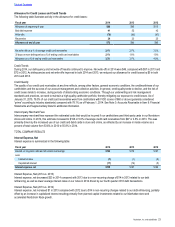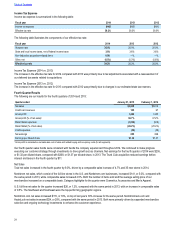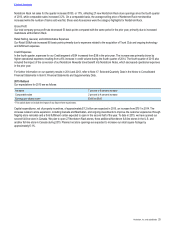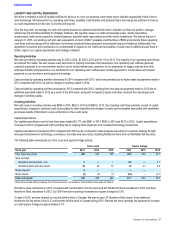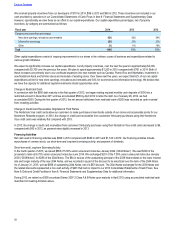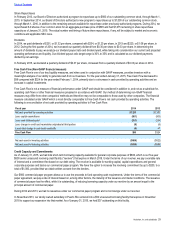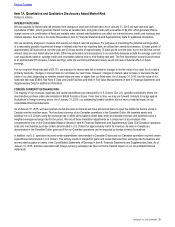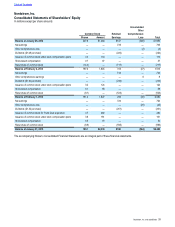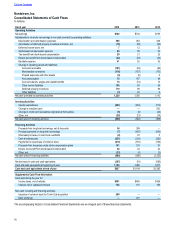Nordstrom 2014 Annual Report Download - page 33
Download and view the complete annual report
Please find page 33 of the 2014 Nordstrom annual report below. You can navigate through the pages in the report by either clicking on the pages listed below, or by using the keyword search tool below to find specific information within the annual report.
Table of Contents
Nordstrom, Inc. and subsidiaries 33
Revenue Recognition
We recognize revenue from sales at our retail stores at the point of sale, net of estimated sales returns and excluding sales taxes. Revenue
from sales to customers shipped directly from our stores, website and catalog, which includes shipping revenue when applicable, is
recognized upon estimated receipt by the customer. We estimate customer merchandise returns based on historical return patterns and
reduce sales and cost of sales accordingly.
Although we believe we have sufficient current and historical knowledge to record reasonable estimates of sales returns, there is a possibility
that actual returns could differ from recorded amounts. In the past three years, there were no significant changes in customer behavior and
we have made no material changes to our estimates included in the calculations of our sales return reserve. A 10% change in the sales
return reserve would have had a $10 impact on our net earnings for the year ended January 31, 2015.
Inventory
Our merchandise inventories are generally stated at the lower of cost or market value using the retail inventory method. Under the retail
method, the valuation of inventories and the resulting gross margins are determined by applying a calculated cost-to-retail ratio to the retail
value of ending inventory. The value of our inventory on the balance sheet is then reduced by a charge to cost of sales for retail inventory
markdowns taken on the selling floor. To determine if the retail value of our inventory should be marked down, we consider current and
anticipated demand, customer preferences, age of the merchandise and fashion trends. Inherent in the retail inventory method are certain
management judgments that may affect the ending inventory valuation as well as gross margin.
We reserve for obsolescence based on historical trends and specific identification. Our obsolescence reserve contains uncertainties as the
calculations require management to make assumptions and to apply judgment regarding a number of factors, including market conditions,
the selling environment, historical results and current inventory trends.
We do not believe that the assumptions used in these estimates will change significantly based on prior experience. In the past three years,
we have made no material changes to our estimates included in the calculations of the obsolescence reserve. A 10% change in the
obsolescence reserve would have had no material impact on our net earnings for the year ended January 31, 2015.
Goodwill
We review our goodwill annually for impairment or when circumstances indicate its carrying value may not be recoverable. We perform this
evaluation at the reporting unit level, comprised of the principal business units within our Retail segment, through the application of a two-
step fair value test. The first step compares the carrying value of the reporting unit to its estimated fair value, which is based on the expected
present value of future cash flows (income approach), comparable public companies and acquisitions (market approach) or a combination of
both. If fair value is lower than the carrying value, then a second step is performed to quantify the amount of the impairment.
As part of our impairment testing, we utilize certain assumptions and apply judgment regarding a number of factors. Significant estimates in
the market approach include identifying similar companies and acquisitions with comparable business factors such as size, growth,
profitability, risk and return of investment and assessing comparable earnings or revenue multiples in estimating the fair value of the reporting
unit. Assumptions in the income approach include future cash flows for the business, future growth rates and discount rates. Estimates of
cash flows may differ from actual cash flows due to, among other things, economic conditions, changes to the business model or changes in
operating performance. For Nordstrom.com, Jeffrey and HauteLook, the fair values substantially exceeded carrying values and therefore we
had no goodwill impairment in 2014, 2013 or 2012. The fair value of Trunk Club’s reporting unit will be tested in 2015. A 10% change in the
fair value of any of our reporting units would not have had an impact on our net earnings for the fiscal year ended January 31, 2015.
Stock-Based Compensation Expense
We recognize stock-based compensation expense related to stock options and restricted stock at their estimated grant date fair value,
recorded on a straight-line basis over the requisite service period. The total compensation expense is reduced by estimated forfeitures
expected to occur over the vesting period of the award. We estimate the grant date fair value of stock options using the Binomial Lattice
option valuation model. Stock-based compensation expense also includes amounts related to HauteLook and Trunk Club stock
compensation based on the grant date fair value. Stock-based compensation expense related to the Trunk Club Value Creation Plan is based
on the grant date fair value of the payout scenario we believe is probable using the Black-Scholes valuation model and is recognized on an
accelerated basis due to performance criteria and graded vesting features of the plan. We also recognize stock-based compensation
expense for performance share units and our Employee Stock Purchase Plan, which are based on their fair values as of the end of each
reporting period.
Calculating the grant date fair value of stock-based awards is based on certain assumptions and requires judgment, including estimating
stock price volatility, forfeiture rates, expected life and performance criteria. A 10% change in stock-based compensation expense would have
a $4 impact on our net earnings for the year ended January 31, 2015.


